
Sophie Penkethman-Young’s Scroll Play
Sophie Penkethman-Young dives into the cursed, chaotic and charming depths of the online world to create inquisitive artworks exploring technology, the internet and capitalism with humour.
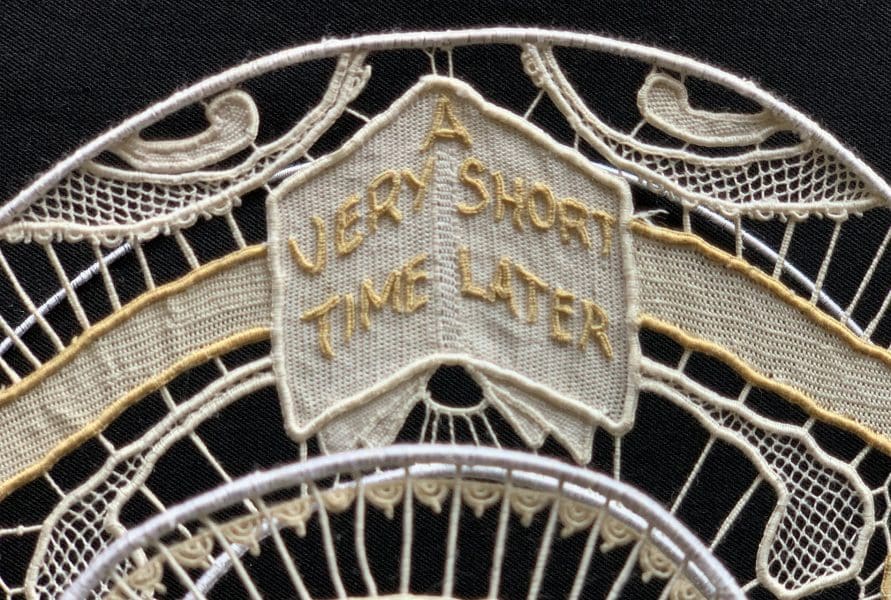
Maggie Hensel-Brown, It’s Nothing Really, (detail) 2019, silk, needle lace, 20 x 28 cm.
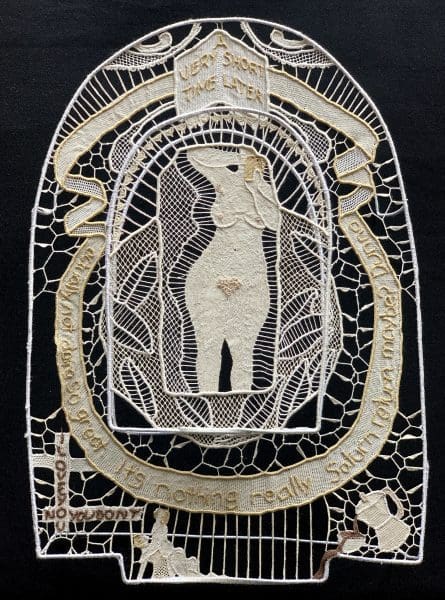
Maggie Hensel-Brown, It’s Nothing Really, 2019, silk, needle lace, 20 x 28 cm.

Maggie Hensel-Brown, Caving to Temptation, silk, needle lace.
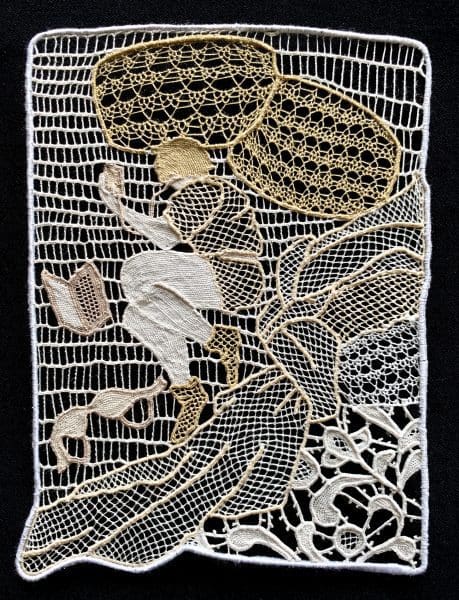
Maggie Hensel-Brown, Quarantine Self Portrait I: Lying, Scrolling, 2020, silk, needle lace, 13 x 18 cm.
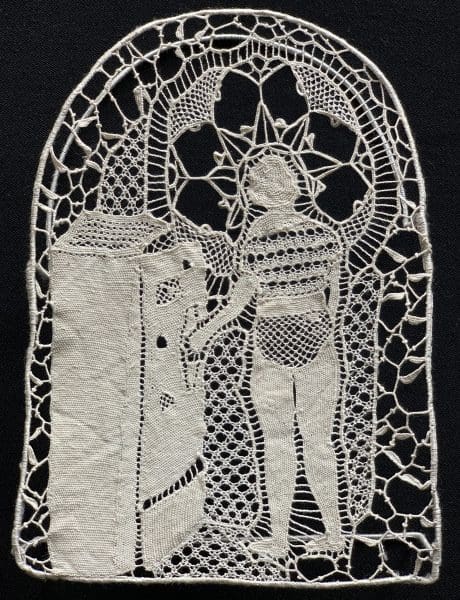
Maggie Hensel-Brown, Staring Into The Void: Not Hungry, Just Bored, 2016-17, silk, needle lace, 12 x 18 cm.
The intricate art of lace-making might bring to mind your grandmother’s tea-table, but it’s long been used to tell grand tales of war and passion, gods and kings. For contemporary lacemaker Maggie Hensel-Brown, this labour-intensive medium can give weight to seemingly banal moments of daily life. Editor Anna Dunnill spoke with the Sydney-based artist about the underground world of lace guilds, and channeling female rage.
Anna Dunnill: Who taught you your first textile techniques?
Maggie Hensel-Brown: This kind of kills the romance of it, because it should be this maternal line, but the answer is actually just—myself! I was raised with five brothers and I think I needed something that was very specifically mine. I have a very vivid memory of teaching myself how to knit with skewers and some twine. It’s been a real lifelong obsession—a thread, pardon the pun, that goes through from childhood.
AD: How did you get into lacemaking?
MHB: The very first class I did was in Melbourne, in 2015, when I learned a needle-lace technique called reticella. I’ve always been someone who likes to go more and more intricate and detailed. Reticella is an Italian technique, developed in the 15th century. You take a piece of existing fabric, usually linen or silk, then you count the threads within the piece of fabric, and you individually remove some and keep others in. Then you weave your own threads back in, in these really intricate painstaking mathematical patterns.
It was my first introduction into the lace world, too. The lace world is nuts—it’s this weird underground, all run in funny little guilds. I mean, it’s thousands of people: they travel for lace, they make friends over lace. These are some of the most well-researched incredible people that you could imagine, but all outside of any institution.
AD: It must be frustrating that the process of lacemaking is so precise and mathematical and focused—but there’s still this perception of it as frivolous frippery.
MHB: [It’s the same] with practitioners as well. Sometimes I’ll go to lace meetings and they’ll show whatever their new piece is; and then in this really self-deprecating way, they’ll be like, “Oh, I’m just going to turn it into a bib for my grandchild, or glue it onto a remote control box,” or something like that. It’s had centuries of being disregarded as work.

AD: There’s a lot of pressure for artists to pump out new work all the time. How does that sit with your much slower process?
MHB: Well, I don’t sell these pieces. I have been happy to exhibit them—but every square centimetre takes about an hour.
When I went on a research trip to England and Italy in 2016, I was quite disillusioned with the combination of capitalism and art. At the time I was living off art—I was running this little gallery—and I didn’t like the feeling of, “My rent’s due, I have to make something and sell it really quickly”. I wanted to give my practice the gift of not having to pay my bills.
But I like having another firm foot in the non-art world as well. Making coffees at a train station kiosk was my job for a long time; working in call centres. Something that keeps you grounded while you can go off on all these lovely adventures.
AD: There’s a real contrast between the fleeting messiness of your subject matter, and the labour and focus of making these tiny precious objects.
MHB: I like making the tiny things really, really special. The works that I have idolised throughout history—the lace works that I’ve traveled to see, and adore—are all incredible pictorial pieces, which were altar cloths in incredible churches or gifts from one royal family to another. The figures in them often show these grand moments [of mythic and historical lore]: Judith beheading Holofernes, or the goddess Diana bathing in a river, or the coronation of King George.
But I’m thinking about all the practitioners who are now basically forgotten—no one knows whose hands are the actual hands that made these works.
And those people weren’t living coronations, or grand Biblical tales. The things that are more relatable and more important now are mundane things—like scrolling through the news articles while there’s a pandemic going on around you, or staring into the fridge. I like giving those moments gravity.
AD: What’s the role of the digital space in your work?
MHB: I sort of hate this, but I think Instagram has actually enhanced my practice in some ways. It’s these tiny little honest moments about your own life that you show to people. On Instagram it’s an instant thing, whereas what I’m doing is…less instant, let’s say. But it’s still similar.
And it’s a very handy tool for the underground lace scene! I follow these beautiful grandmothers in Italy and Romania who are incredible lacemakers. It’s a good connector.
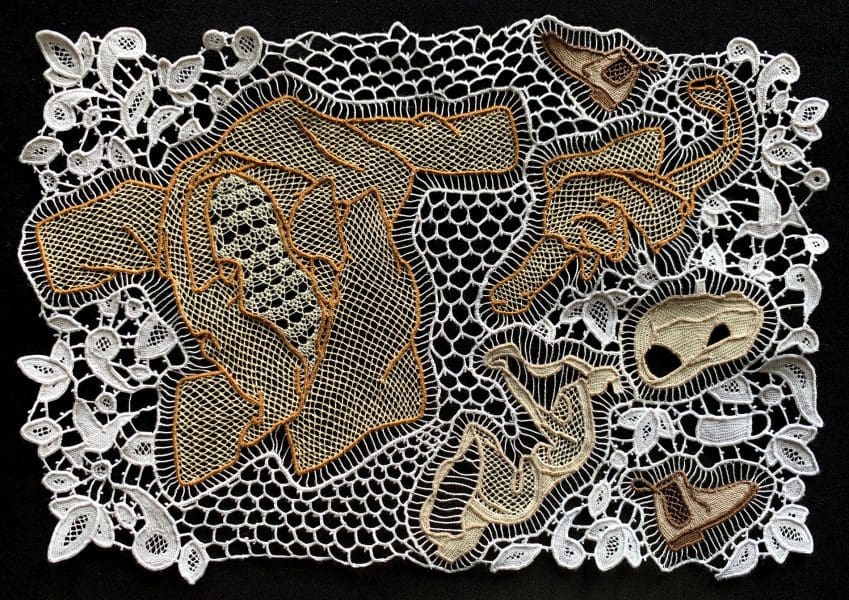
AD: Does drawing play a part in your process?
MHB: It’s everything. I’ve been very much a drawer since forever. I’ll have a moment of inspiration—when I’m in my knickers looking in the fridge, or filming my brother doing a dumb dance—and I’ll go, “Oh, this is it.” And then I’ll go for a really long walk and all of the elements drop into place. Then I go home and draw all the weird bits onto a piece of paper, and then rip them apart and move them around, stick them back together, and trace it.
A needle-lace design is worked on top of a drawing, and then you cut all the threads off at the end. The drawing is always there.
AD: Do you work from a studio space, or does the lace travel around with you?
MHB: The lace mostly travels with me, in this little pencil case that says Miami Vice on it. I find sitting on trains really good—if I go to visit my family in Newcastle I’ll do a lot of lace-making on the train. It’s very portable.
AD: What stories do you want to tell in the future?
MHB: There are two stories I’ve been researching lately, that have been told and retold through lace. I mentioned them before; one is the story of Judith beheading Holofernes, the Biblical tale. Holofernes was basically an awful despotic leader who was taken down and beheaded by a sexy lady—you know, all that good stuff. There are three quite famous lace pieces that are in big museums around the world; one of them is here in Sydney at the Powerhouse Museum.
The other story that I love is about the Roman goddess Diana bathing in the river, and the hunter Actaeon coming upon her, and her complete rage at that. She turns him into a deer, and then basically sets his own dogs on him and he dies. It’s an absolutely horrible story! But again, it’s this story of righteous women’s anger.
And to me, it’s not a surprise that that it’s showing up in this unappreciated work constantly. It’s angry women, all through these very famous pieces of lace. So there’s something about that kind of powerful female anger that I just want to delve into a little bit more.
Festival of Lace
Gallery76, Embroiderers’ Guild NSW
30 January—4 March
This interview was originally published in the January/February 2021 print edition of Art Guide Australia.